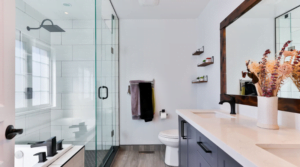
In today’s fast-paced world, many individuals are finding solace in minimalist living. This lifestyle shift focuses on reducing excess and creating a calm and clutter-free home environment. If you’re seeking a simpler, more intentional way of living, join us as we explore the concept of minimalist living and discover practical tips to transform your living space.
Understanding Minimalist Living:
Embracing a minimalist lifestyle involves consciously choosing to live with less. It’s about decluttering your physical and mental space to make room for what truly matters. By simplifying your surroundings, you can experience increased clarity, reduced stress, and a greater sense of peace.
Benefits of Minimalist Living:
Minimalism offers numerous benefits beyond an organized home. Some advantages include:
- Enhanced focus and productivity: With fewer distractions, you can concentrate on your priorities and achieve greater productivity.
- Reduced stress: A clutter-free environment promotes relaxation and reduces mental clutter, resulting in lower stress levels.
- Financial freedom: By curbing excessive consumption, you can save money and prioritize spending on experiences and things that truly bring you joy.
- Environmental impact: Embracing minimalism supports sustainable living by reducing waste and consumption.
Practical Steps to Embrace Minimalism:
Decluttering:
Start by decluttering your living space systematically. Sort your belongings into categories and decide what to keep, donate, or discard. Ask yourself if each item serves a purpose or brings you joy. Adopting the “KonMari” method, popularized by Marie Kondo, can help you make intentional choices.
Simplifying your Wardrobe:
Streamline your wardrobe by keeping only the items you truly love and wear regularly. Embrace a capsule wardrobe approach, where you curate a small collection of versatile and timeless pieces that can be mixed and matched effortlessly.
Mindful Consumption:
Adopt mindful consumption habits by questioning your purchasing decisions. Consider whether a new item aligns with your values and brings long-term value to your life. Prioritize quality over quantity and focus on experiences rather than material possessions.
Organizing and Storage Solutions:
Invest in practical storage solutions that help you maintain an organized space. Utilize minimalistic storage containers, labels, and furniture with hidden compartments to keep your belongings tidy and easily accessible.
Creating a Calming Minimalist Home Environment:
Neutral Color Palette:
Opt for a neutral color palette, such as whites, grays, and earth tones, to create a sense of serenity and cohesion throughout your home. These colors provide a blank canvas for simplicity and allow natural light to enhance the space.
Functional and Thoughtful Furniture:
Choose furniture pieces that serve a purpose and have a clean and timeless design. Focus on functionality and avoid excessive ornamentation. Optimize your layout to maximize space and ensure a comfortable flow.
Letting in Natural Light:
Maximize natural light by keeping windows unobstructed and utilizing light-filtering curtains or blinds. Natural light not only brightens your space but also uplifts your mood.
Incorporating Plants:
Introduce indoor plants to bring life and a touch of nature into your minimalist home. Plants not only add visual appeal but also contribute to improved air quality and a sense of tranquility.
Minimalism Beyond Physical Space:
Minimalism extends beyond decluttering your physical environment. Consider applying minimalist principles to other aspects of your life, such as digital decluttering, simplifying your schedule, and fostering meaningful relationships.
Embracing minimalist living can have a profound impact on your overall well-being. By creating a calm and clutter-free home environment, you open doors to increased productivity, reduced stress, and a more intentional way of living. Start your minimalist journey today and experience the transformative power of simplicity.



